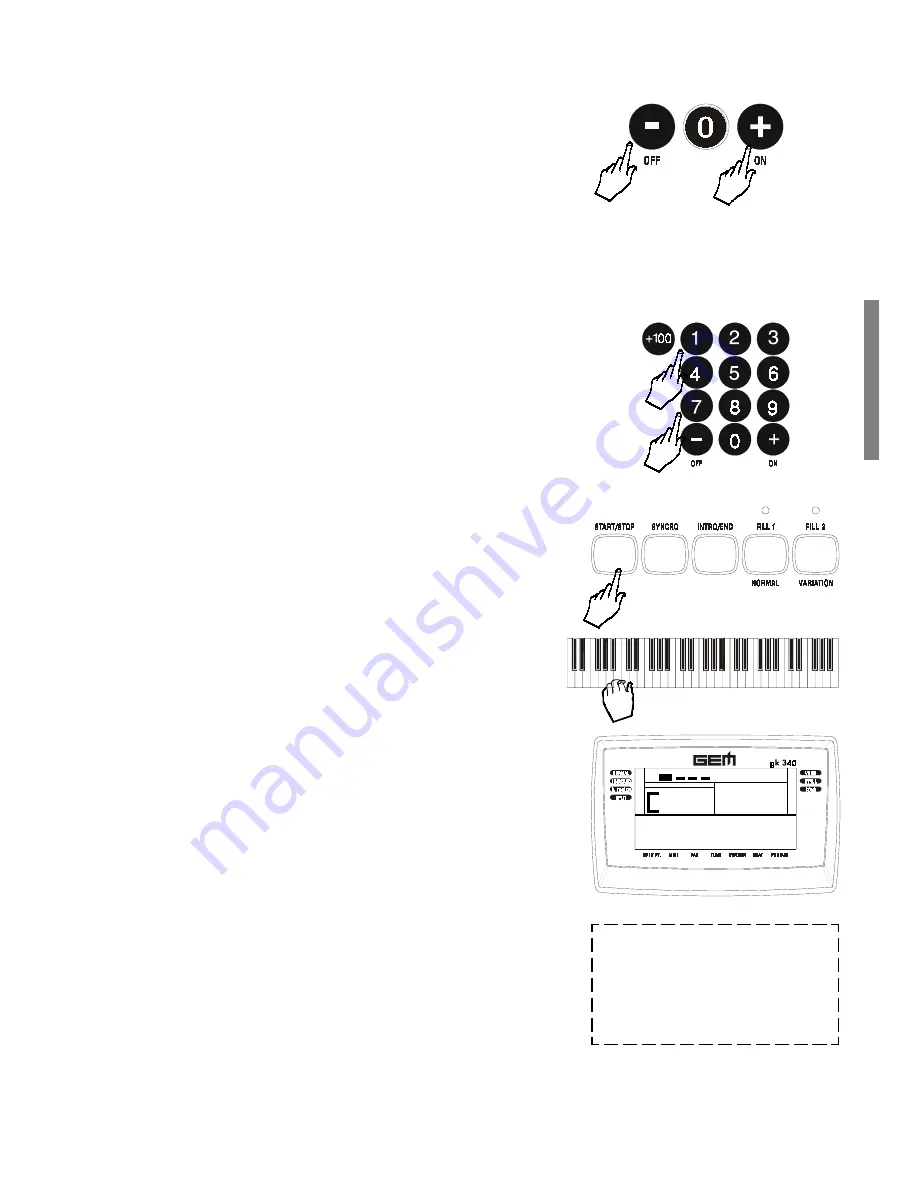
GK340 9
4
Use the numeric keypad to select a Style
Using the numeric keypad is the quickest way to go directly
to the Style you need, but first, you must know the exact
number of the Style. The name and corresponding number
of all the Styles in memory are silkscreened above the display
on the left. Youll see that they are organized in Groups (8
BEAT, 16 BEAT, ROCK, etc.) and numbered from 01 through
to 96. Select the Style you want by entering the corresponding
two digits in sequence.
5. For example, to select Style number 17 (Shuffle 2), press
button
[1]
then
[7]
.
Selecting the Styles by recalling the Memory
Another quick way of selecting the Styles is by selecting the
Performances, but this means that you have to remember
which Style is memorized in the Memoriy.
If you use the Performances to select Styles, remember to
turn off the S.T. PLAY button. You can also memorize your
preferred Styles to these buttons with Write Memory. This
argument is explained in detail further ahead on page 16.
Playing the Styles
6. Once you have selected a Style, press the
[START/STOP]
button.
Youll hear the Drums accompaniment track start to play.
7. Play a note or chord on the left part of the keyboard below
note F#3 to trigger the automatic accompaniments.
An automatic accompaniment will start to play, generated
by the Style sections: Drums, Bass and Accomp. As you change
chord from Major to minor or seventh, etc., you will notice a
change of style pattern. Each time you change key, for example,
from C to F, the Style pattern will transpose automatically.
The names of the recognized chords are displayed in the left hand
corner of the display. For example, if you play the chord of C, the
display will show the large letter C. If you play a chord not
recognized by the instruments chord recognition system, the
current pattern will not change until you play a recognized chord.
Also shown in the display are 4 round Beat pattern indicators
which show the current beat of the bar as you play your style.
The first bar of every two-bar cycle shows all 4 indicators,
while every other beat shown one small indicator. The first
beat of the second bar is shown with the larger beat indicator.
To play your Style using the automatic functions (Var, Key
Start, Intro, Fill, Ending), see the section entitled Using
the Style Auto functions further ahead.
8. Press the
[START/STOP]
button if you want to stop the Style.
You can select a Style in three different ways:
Use the
[-]
and
[+]
buttons to select a Style
In STYLE mode, the
[]
and
[+]
buttons of the numeric
keypad step through the individual Styles one by one.
3. Press the
[+]
button to select the Styles in increasing
numerical order.
4. Press the
[]
button to select the Styles in reverse order.
Holding the button down scrolls rapidly forwards or backwards
through all the Styles. The selected Style number is shown
at the center of the display.
NOTE: If you hear a Drum pattern only
without automatic accompaniment
when you play a note or chord on the
Lower keyboard, check that you are
not in NORMAL or SPLIT mode. The
arrowhead must point to either
FINGERED or ONE FINGER for the
Style accompaniment to play.
























